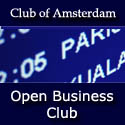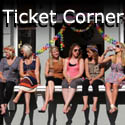|
|
|
| .Synthesis
of elBulli cuisine |

|
|
By
Chef
Ferran
Adrià
El Bulli -
Roses, Spain |
|
In
the mid-1990s a new style of cuisine began to be forged. Ferran
Adrià is the creator of the synthesis of elBulli cuisine.
elBulli has been voted the best restaurant in the world.
1.
Cooking is a language through which all the following properties
may be expressed: harmony, creativity, happiness, beauty, poetry,
complexity, magic, humour, provocation and culture.
2.
The use of top quality products and technical knowledge to prepare
them properly are taken for granted.
3.
All products have the same gastronomic value, regardless of their
price.
4.
Preference is given to vegetables and seafood, with a key role
also being played by dairy products, nuts and other products that
make up a light form of cooking. In recent years red meat and
large cuts of poultry have been very sparingly used.
5.
Although the characteristics of the products may be modified (temperature,
texture, shape, etc.), the aim is always to preserve the purity
of their original flavour, except for processes that call for
long cooking or seek the nuances of particular reactions such
as the Maillard reaction.
6.
Cooking techniques, both classic and modern, are a heritage that
the cook has to know how to exploit to the maximum.
7.
As has occurred in most fields of human evolution down the ages,
new technologies are a resource for the progress of cooking.
8.
The family of stocks is being extended. Together with the classic
ones, lighter stocks performing an identical function are now
being used (waters, broths, consommés, clarified vegetable
juses, nut milk, etc.).
9.
The information given off by a dish is enjoyed through the senses;
it is also enjoyed and interpreted by reflection.
10.
Taste is not the only sense that can be stimulated: touch can
also be played with (contrasts of temperatures and textures),
as well as smell, sight (colours, shapes, trompe d’oeil,
etc.), whereby the five senses become one of the main points of
reference in the creative cooking process.
11.
The technique-concept search is the apex of the creative pyramid.
12.
Creation involves teamwork. In addition, research has become consolidated
as a new feature of the culinary creative process.
13.
The barriers between the sweet and savoury world are being broken
down. Importance is being given to a new cold cuisine, particularly
in the creation of the frozen savoury world.
14.
The classical structure of dishes is being broken down: a veritable
revolution is underway in first courses and desserts, closely
bound up with the concept of symbiosis between the sweet and savoury
world; in main dishes the "product-garnish-sauce" hierarchy
is being broken down.
15.
A new way of serving food is being promoted. The dishes are finished
in the dining room by the serving staff. In other cases the diners
themselves participate in this process.
16.
Regional cuisine as a style is an expression of its own geographical
and cultural context as well as its culinary traditions. Its bond
with nature complements and enriches this relationship with its
environment.
17.
Products and preparations from other countries are subjected to
one's particular style of cooking.
18.
There are two main paths towards attaining harmony of products
and flavours: through memory (connection with regional cooking
traditions, adaptation, deconstruction, former modern recipes),
or through new combinations.
19.
A culinary language is being created which is becoming more and
more ordered, that on some occasions establishes a relationship
with the world and language of art.
20.
Recipes are designed to ensure that harmony is to be found in
small servings.
21.
Decontextualisation, irony, spectacle, performance are completely
legitimate, as long as they are not superficial but respond to,
or are closely bound up with, a process of gastronomic reflection.
22.
The menu de dégustation is the finest expression of avant-garde
cooking. The structure is alive and subject to changes. Concepts
such as snacks, tapas, pre-desserts, morphs, etc., are coming
into their own.
23.
Knowledge and/or collaboration with experts from different fields
(gastronomic culture, history, industrial design, etc.,) is essential
for progress in cooking. In particular collaboration with the
food industry and the scientific world has brought about fundamental
advances. Sharing this knowledge among cooking professionals has
contributed to this evolution.
|
Visit
our event about
 'the
future of Food Design'
Thursday, November 23,
2006
'the
future of Food Design'
Thursday, November 23,
2006
Registration: 18:30-19:00, Conference: 19:00-21:15
Where: ROC, Hotelschool, Da Costastraat 64, Amsterdam
|

|
| .Club
of Amsterdam blog |

|
 |
 Club
of Amsterdam blog
Club
of Amsterdam blog
http://clubofamsterdam.blogspot.com
October 14:  The
new Corinthians: How the Web is socialising journalism
The
new Corinthians: How the Web is socialising journalism
September 20:  A
Future Love Story
A
Future Love Story
September 17:  The
Future of Business Meetings: Applications for AMI Technologies
The
Future of Business Meetings: Applications for AMI Technologies
|

|
| .News
about Food Design |
| |
|
|
 |
|
 Food
structuring
Food
structuring
Humanity has been creating food structures to suit changing tastes
and needs for millennia. But to deliver new types of food to customers
who expect the best, means taking cooking beyond the possibilities
of the kitchen.
Traditionally food structuring was cooking. But to create entirely
new food structures with special functions, we need to go beyond the
possibilities of experimental cuisine. Food structuring is an emerging
discipline that uses all the investigative technology available. Food
is examined from the molecular, to the microscopic, to the macro scale.
The idea is to build on the culinary experience, the artistry of cooking,
so that novel edible creations can make the transition from the stove
to the shelves. This area is gaining momentum under the header "Molecular
Gastronomy" where 3 star Michelin chefs are working with Food
Sciences to define this exciting new area.
Food structural design is by no means exclusively concerned with changing
food appearance and flavour. Altering food structures can have a significant
impact on people’s lives. For instance, a particular problem
in developing countries is inadequate refrigeration and the lack of
manufacturing infrastructure. Intended to address these problems,
new spreads and manufacturing techniques have been developed by Unilever
specifically for developing world conditions. Spreads can now be locally
produced on a small scale, or even at home, and require less refrigeration.
High quality products are being produced to meet the needs of low-income
consumers.
|
| |
|
|
 |
|
 Molecular
Gastronomy
Molecular
Gastronomy
“Molecular gastronomy is the application
of science to culinary practice and more generally gastronomical phenomena.”
So says Wikipedia. Harold McGee defines molecular gastronomy as "The
scientific study of deliciousness".
INICON: Science can only change the culinary activities if it helps
the cooks to prepare the dishes ; it can probably not change the kind
of food we eat. Our sensory apparatus, created by millions of years
of evolution, has a function: telling the brain what we are eating,
and giving some pleasure when the food is appropriate from the physiological
and psychological point of view. Science would do a better job if
it helped the cooks to cook better and to obtain more regularly appropriate
textures and tastes from the raw products.
|

|
|
|
| .News
about the Future |
| |
|
|
 |
|
 Hyperscan
Hyperscan
Innovision Research &
Technology, a leading developer of NFC (Near Field Communication)
and UHF & HF RFID (Radio Frequency Identification) solutions,
is providing the contactless RFID reader and re-writable video tag
technology at the heart of Mattel's new HyperScan hybrid games platform.
Hyperscan is unique in combining modern video gaming with classic
collector card play.
The collectable game cards, supplied with the HyperScan games, will
be available based on a rarity scheme, meaning that players won't
know what cards they are getting in their game booster packs, spawning
a new trend in powered-up collector card trading.
|
| |
|
|
 |
|
 Battery-Powered
Plane
Battery-Powered
Plane
The students-developed manned plane powered
by 160 AA “Oxyride” batteries flew for 59 seconds covering
391.4 meters and soared as high as 6.11 meters above the ground
at a private airport owned by Honda Motor Co.”
The world’s first
battery-powered plane was developed by Tokyo Tech students and Matsushita
Electric Industrial Co.
|

|
|
|
| .Next
Season Event |

|
|
 the
future of Food Design
the
future of Food Design
Thursday, November 23, 2006
Registration: 18:30-19:00, Conference: 19:00-21:15
Where: ROC, Hotelschool, Da Costastraat 64, Amsterdam
 Tickets
for € 30, € 20 [discount] or € 10 [students]
Tickets
for € 30, € 20 [discount] or € 10 [students]
Food Tasting at
cost and your choice
Masayuki Tajima, food culture specialist:
What is Food Design?
Maurice Nio,
Owner, NIO architecten:
Fire Emperor
Angélique Schmeinck,
Master Chef:
Experience & Temptation… The
creator as seducer
Moderated by
Mikael Besson, Chef,
freelancer for the gastronomy and hospitality industry
Taste, presentation
of food, atmosphere, even design of food itself have existed for
a long time, but they were often treated as separate elements. The
contemporary awareness in design as well as in food culture enable
a more holistic approach, which recently led to outstanding creative
developments.
This event is going
to highlight three influential aspects: a) aesthetics from a consumer
perspective, b) innovative food products and c) design supporting
senses and a good time.
|
Supporters:
 ............... ...............
|

|
|
|
| .”They
think the unthinkable and do it.” |
| |
|
|

|
|
Ralph
Freelink
Psychologist Catalyst in the Knowledge
Stream Trade - Asian Leadership
Founder, Centre for Holistic Inquiry
|
|
“They think the
unthinkable and do it.” – Summit Quote
We gathered for three
days from all over the world to talk about the future. What did
we take home? The Summit of the Future dealt with the future of
risk. What is risk? How do we relate to risk? And what does risk
have to offer us? In three days we exchanged a wide spectrum of
opinions and perspectives. In this report I would like to explore
risk from the psychological perspective of letting go.
What is the future
of risk? I believe it has everything to do with the risk of letting
go. Letting go of those things that we wish to control and change.
Letting go is not about indifference, nor is it a form of negligence.
Letting go has to do with a new form of leadership that is emerging.
It’s about the ability to surrender to the process of self-orga-nisation,
without trying to im-pose change on the world. We have a chance
to create the future, but in a way that is in alignment with the
forces that permeate and encompass our lives.
Letting go is a subtle
way of dealing with the future. When we learn to let go we are
actually bringing something qualitative forth. With this unnameable
quality in our midst, we can learn to organise things in a way
that we can never achieve on our own. This new awareness is dawning
globally, and has everything to do with rising need for spiritual
inquiry on an individual, collective and systemic level. Through
inquiry we can learn to notice the subtler, less tangible aspects
of reality, which, once noticed and acknowledged, can radically
shift our quality of life. We can then learn to enable this process
of self-organisation and bring forth a more coherent world.
Sounds like fiction?
In actuality our mode of consciousness is still in the way of
this potential, but people are gradually opening up to it as the
pressure of our global crisis intensifies. It is obvious that
we can’t create a new future together, when we don’t
engage on a deeper level and truly learn how to think and act
together. We have to sit down to inquire, share and build community.
We need to clear the surface and adopt a beginner’s mind
to look at ourselves and the world afresh.
A word much used
at the conference was ...
|
|
Read the full article
in the  Summit
for the Future Report 2006!
Summit
for the Future Report 2006!
|
|
|

|
|
|
| .Recommended
Book |
| |
|
|
 |
|
 Eating
Architecture
Eating
Architecture
by Jamie Horwitz (Editor), Paulette Singley
(Editor)
The contributors to this highly original collection of essays explore
the relationship between food and architecture, asking what can be
learned by examining the (often metaphorical) intersection of the
preparation of meals and the production of space. In a culture that
includes the Food Channel and the knife-juggling chefs of Benihana,
food has become not only an obsession but an alternative art form.
The nineteen essays and "Gallery of Recipes" in Eating Architecture
seize this moment to investigate how art and architecture engage issues
of identity, ideology, conviviality, memory, and loss that cookery
evokes. This is a book for all those who opt for the "combination
platter" of cultural inquiry as well as for the readers of M.
F. K. Fisher and Ruth Reichl.
The essays are organized into four sections that lead the reader from
the landscape to the kitchen, the table, and finally the mouth. The
essays in "Place Settings" examine the relationships between
food and location that arise in culinary colonialism and the global
economy of tourism. "Philosophy in the Kitchen" traces the
routines that create a site for aesthetic experimentation, including
an examination of gingerbread houses as art, food, and architectural
space. The essays in "Table Rules" consider the spatial
and performative aspects of eating and the ways in which shared meals
are among the most perishable and preserved cultural artifacts. Finally,
"Embodied Taste" considers the sensual apprehension of food
and what it means to consume a work of art. The "Gallery of Recipes"
contains images by contemporary architects on the subject of eating
architecture.
|

|
|
|
| .The
new Corinthians: How the Web is socialising journalism |
|
|
|
 The
new Corinthians: How the Web is socialising journalism
The
new Corinthians: How the Web is socialising journalism
by Milverton Wallace, founder/organiser of the European Online Journalism
Awards
|
|
The momentum of change is with the new Corinthians. The open source
ethos and method of work/production, which began in the periphery
with collaborative software development, is moving to centre stage
by way of the blogging revolution and open standards in web services.
In tagging, syndication, ranking and bookmarking we have the rudiments
of a peer-to-peer trust, reputation and recommendation system well
suited to self-regulating collaborative networks.
James Cameron (1911-1985),
arguably the greatest British journalist of the last 100 years,
always insisted that journalism is a craft. Now "craft"
implies pride in work, integrity in dealing with customers, rites
of passage, and long years of training to acquire the requisite
skills/knowledge.
But that was then. Today, journalism is a "profession".
Many aspiring hacks now need a university or other accredited
"qualification", and, except in the Anglo-American world,
a government issued licence to "qualify" as a journalist.
In some countries you're compelled by regulations to belong to
a recognised association and to obey its code of standards in
order to practice and earn a living as a journalist.
The march towards
professionalism began with the rise of the mass media in the latter
part of the 19th century, a development made possible by the invention
of the rotary printing press, cheap papermaking from wood pulp,
and mass literacy.
Cheap mass circulation
newspapers gave proprietors the kind of political influence they
never had before. The press was becoming an increasingly powerful
social force, a counter-balance to big business and the state.
However, this power was fragile. Corporations and governments
resisted the press's self-appointed role of watchdog and muckraker.
But the press barons fought back.
In response to state
and corporate resistance to openness and disclosure of information,
they raised the banner of "the public's right to know"
as a fundamental democratic freedom. To counter charges of irresponsible
reporting, journalists developed rigorous techniques for gathering,
distilling and presenting information; and, to standardise these
procedures and wrap them in an ethical framework, a normative
model for reporting, carved in stone, was crafted: impartiality,
objectivity, accuracy, transparency.
Thus was Cameron's
craft gradually "professionalised", and, in the process,
turned into an exclusive club with a privileged membership.
Today, this carefully
constructed edifice is crumbling as the read/write web blows away
the need to be a member of any such club to be able to practise
journalism. Arguments about who is or isn't a journalist is a
sideshow, a pre-occupation mostly of self-styled guardians of
truth. The inexorable fact is that the genie is out of the bottle
and a significant number of "unqualified" people are
"doing journalism" without permission from anyone.
So, let us accept
that the "authorities" can no longer decide who is or
isn't a journalist. We have no choice. But we need to ask some
crucial questions: Who will now enforce the rules and codes? What
is to become of them? Should we care? Do we still need them? Are
they "fit for purpose" in the digital age?
Digital media, and
in particular, it's social offsprings - social media such as blogs,
vlogs, wikis, IM; social networks such as MySpace, Facebook, Bebo,
Tagworld, Orkut etc., and social bookmarking services such as
Furl, Del.icio.us, DIGG, StumbleUpon, MyWeb - have enabled the
amateurisation of the media. The barbarians have entered the gates.
Is the empire on the verge of collapse?
Nowadays, the word
"amateur" is being deployed by media professionals to
belittle the media-making efforts of bloggers and others who create
media productions outside the journalism guilds. Such reporting
is deemed "unreliable", "biased", "subjective";
they are "unaccountable", the facts and the sources
"unverifiable".
All of this must
be puzzling to ...
Read the full article
 click
here
click
here
|

|
| .Global
Competitiveness Report 2006-2007 |
 Global Competitiveness Report 2006-2007
Global Competitiveness Report 2006-2007
Switzerland, Finland and Sweden are the world’s
most competitive economies according to The Global Competitiveness
Report 2006-2007, released by the World Economic Forum on 26
September 2006. Denmark, Singapore, the United States, Japan, Germany,
the Netherlands and the United Kingdom complete the top ten list,
but the United States shows the most pronounced drop, falling from
first to sixth.
The rankings are drawn from a combination of publicly available
hard data and the results of the Executive Opinion Survey, a comprehensive
annual survey conducted by the World Economic Forum, together with
its network of Partner Institutes (leading research institutes and
business organizations) in the countries covered by the Report.
This year, over 11,000 business leaders were polled in a record
125 economies worldwide.
|
1.
Switzerland
2. Finland
3. Sweden
4. Denmark
5. Singapore
6. US
7. Japan
8. Germany
9. Netherlands
10. UK
11. Hong Kong
12. Norway
13. Taiwan,China
14. Iceland
15. Israel
16. Canada
|
"The top rankings
of Switzerland and the Nordic countries show that good institutions
and competent macroeconomic management, coupled with world-class
educational attainment and a focus on technology and innovation,
are a successful strategy for boosting competitiveness in an increasingly
complex global economy." - Augusto Lopez-Claros, Chief
Economist; Director, Global Competitiveness Network
"The world economy is not a zero-sum game. Many nations can
improve their prosperity if they can improve productivity. The
central challenge in economic development, then, is how to create
the conditions for rapid and sustained productivity growth."
- Michael E. Porter, Bishop William Lawrence University Professor,
Harvard Business School
"The process of growth is complex. The Growth Competitiveness
Index is an attempt to capture this complexity by modelling growth
as a complicated combination of factors that matter differently
for different countries." - Xavier Sala-í-Martin,
Professor, Economics Department, Columbia University
|

|
| .Waterarchitecture |
|

|
|
A leader in this movement is architect Koen Olthuis, who considers
floating buildings the wave of the future.
He foresees a world
of not only floating houses, but floating roads, hotels, offices,
churches, restaurants and conference centers. "I think there
are great opportunities for this in America, where the timber used
for many homes is good for the water," Olthuis said.
Olthuis, 35, has been focusing on floating architecture since founding
his architectural firm Waterstudio.
|

Watervilla
in Leiden, The Netherlands
by
Waterstudio

Watervilla de Hoef, The Netherlands by Waterstudio

Floating Boulevard, Antwerpen, Belgium by
Waterstudio

Floating
and rotating hotel tower, Dubai, UAE by Waterstudio

Health
Enjoyment & Challenge Center, Aruba by Waterstudio
|

|
| .Agenda |
 |
 Tickets
for Seasons Events:
€ 30,
€
20
[discount] or
€
10
[students]
Tickets
for Seasons Events:
€ 30,
€
20
[discount] or
€
10
[students]
Our Season Events for 2006/2007 are on Thursdays:
|
 the
future of Food
Design
the
future of Food
Design
November 23, 2006, 18:30 - 21:15
 the
future of
Consciousness
the
future of
Consciousness
January 25, 2007, 18:30 - 21:15
the future
of Ambient Intelligence
February 22, 2007,
18:30 - 21:15
the future of Global Workplace
March 29, 2007,
18:30 - 21:15
the
future of Success
April 26, 2007, 18:30 - 21:15
the future of Tourism
May 31, 2007, 18:30 - 21:15
Taste
of Diversity
June 28, 2007, 18:30 - 21:15
|
|
|

|
|
|
| .Club
of Amsterdam Open Business Club |

|
|
 Club
of Amsterdam Open Business Club
Club
of Amsterdam Open Business Club
Are you interested in networking, sharing visions,
ideas about your future, the future of your industry, society, discussing
issues, which are relevant for yourself as well as for the 'global'
community? The future starts now - join our
online platform
...:
http://www.openbc.com/go/invuid/Felix_Bopp2
CIWI
- Creative Minds Worldwide
 CIWI
Club of Amsterdam Forum
CIWI
Club of Amsterdam Forum
|

|
|
|
| .Contact |
Your
comments, ideas, articles are welcome!
Please write to Felix Bopp, Editor-in-Chief:
editor@clubofamsterdam.com
|

|
| .Subscribe
& Unsubscribe |
Subscription
http://www.clubofamsterdam.com/subscription.htm
To unsubscribe:
http://www.ymlp.com/unsubscribe.php?ClubofAmsterdamJournal
|

|
| m |
|

























 ....
....